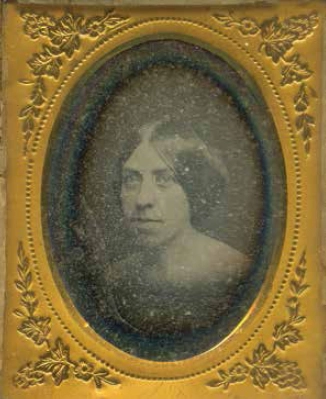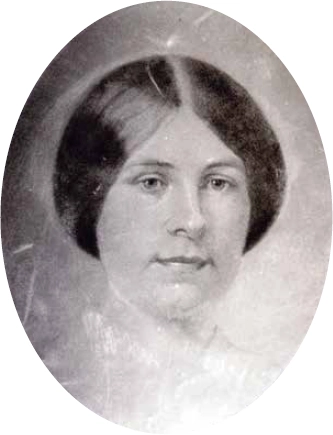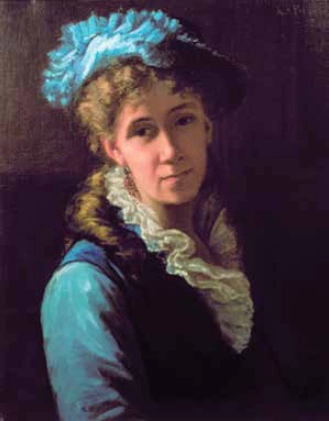Near the end of her life, Anna Alcott recalled:
In the good old times, when ‘Little Women’ worked and played together, the big garret [at Hillside] was the scene of many dramatic revels. After a long day of teaching, sewing, and ‘helping mother,’ the greatest delight of the girls was to transform themselves into queens, knights, and cavaliers of high degree, and ascend into a world of fantasy and romance. . . . Flowers bloomed, forests arose, music sounded, and lovers exchanged their vows by moonlight. Nothing was too ambitious to attempt; armor, gondolas, harps, towers, and palaces grew as if by magic, and wonderful scenes of valor and devotion were enacted before admiring audiences.27
By this time, the girls had each begun to show the outlines of the personalities that Alcott was later to bring to full development in Little Women. Eldest sister Anna was perhaps the sister with whom Louisa was to take the broadest liberties in writing Little Women. By her own modest admission, Anna was not as stunningly attractive as Meg March was to be; she claimed never to have been “the pretty, vain little maiden, who coquetted and made herself so charming.” Anna later averred that Louisa intentionally beautified her for her place in Little Women partly because Louisa admired her older sister and partly because, as Louisa herself put it, “Dear me, girls, we must have one beauty in the book!”28 But Anna disguised her plainness with her exceptional fluidity of motion and, as Emerson’s son Edward observed, a “beauty of expression [that] made up for the lack of it in her features.”29 When Bronson pictured her in his mind, he saw “her beauty-loving eyes and sweet visions of graceful motions and golden hues and all fair and mystic shows and shapes.”30

Louisa’s older sister Anna Bronson Alcott (1831–1893), shown here in her mid-twenties, played the starring roles in the Alcott sisters’ theatricals. She dreamed of a life on the stage, but premature deafness thwarted her ambition. Louisa fictionalized her as Meg in Little Women. (Louisa May Alcott Memorial Association)
When his thoughts turned to Lizzie, who would be immortalized as Beth, Bronson spoke of “her quiet-loving disposition and serene thoughts, her happy gentleness and deep contentment.” He also added a curious phrase: “self-centered in the depths of her affections.”31 In Little Women, Alcott notes the same paradox in Beth, “who seemed to live in a happy world of her own, only venturing out to meet the few whom she trusted and loved.” Perhaps the most naturally affectionate of the Alcott girls, Lizzie lacked her sisters’ creative spark. She was also the most inward-looking. In comparison with her three bolder sisters, she was almost emotionally inaccessible, and she liked it that way. In a family that freely read aloud to one another from their journals, Lizzie alone kept her personal jottings resolutely to herself. That Alcott herself felt a special closeness to Lizzie can be inferred from the text of Little Women, where Lizzie’s character is the only one of the March sisters not to be refitted with a different Christian name. Jo and Beth are drawn together “by some strange attraction of opposites.” Beth confides her secrets “to Jo alone” and exerts arguably more influence over her than anyone else in the March family. Yet one senses that even Louisa did not penetrate to the core of Lizzie’s flitting, elusive spirit. Timid, silent Lizzie was, and remains, the most shadowy presence in the Alcott family.

The only known likeness of Elizabeth Sewall Alcott (1835–1858), the third of the four Alcott sisters. Like Beth in Little Women, Lizzie was quiet and retiring. Like Beth as well, she died tragically young from the lingering effects of scarlet fever. (Louisa May Alcott Memorial Association)
To Lizzie’s muted tones, May Alcott provided a bright and energetic contrast. While a toddler, May was a child of “frolick joys and impetuous griefs,” a small whirlwind of “fast-falling footsteps” with a “sagacious eye and auburn locks.” In describing her, Bronson took special notice of May’s “word-forming tongue,” an amusing point in light of the many hapless malapropisms of her young fictional counterpart.32 When May was twenty, Louisa remarked upon her liveliness, as well as how “old & still” the house felt when she was gone.33 Strong-willed and artistically gifted, she struck some in her early years as “haughty” and “childishly tyrannical.”34 Others, like Nathaniel Hawthorne’s son, Julian, fell in love with her. She was tall with abundant blond hair, although, like Amy in Little Women, she despaired over her decidedly non-Grecian nose and, as in the novel, tried in vain to cure its irregularities with a clothespin. To Louisa, May seemed born under a lucky star, as fated for frolic and delight as Alcott herself felt destined for drudgery. Sometimes with pride and pleasure, sometimes ruefully, and sometimes from mere force of habit, Louisa grew accustomed to toiling and sacrificing so that May might have better opportunities and more enjoyment.

The youngest of the Alcott sisters, Abby Alcott (1840–1879) preferred to be known by her middle name, May. An aspiring artist, she struggled with the illustrations of the first edition of Little Women. She improved greatly thereafter and had paintings exhibited at the prestigious Paris Salon. (Painting by Rose Peckham; Louisa May Alcott Memorial Association)
Unable to earn the money needed to maintain their residence at Hillside, the Alcotts moved back to Boston in 1848. Here, their fortunes reached their lowest ebb. For the next half-dozen years, they were, to use Louisa’s phrasing, “poor as rats.”35 In general, both the family’s lack of means and the four girls’ acute sensitivity to one another’s needs drew them together very closely. While Bronson’s paid conversations brought in a small but welcome sum, each of the girls discovered a role to play in keeping the family going.
1 comment